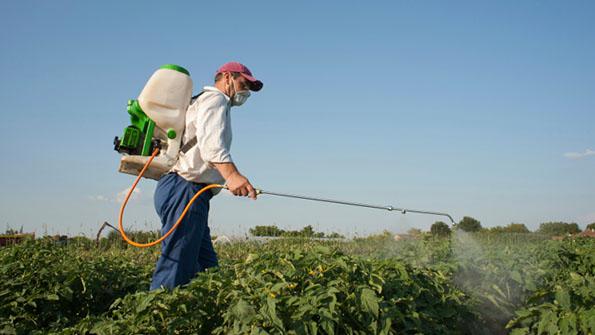A recent update of a very large study of diseases of pesticide applicators identified a possible association between glyphosate use and acute myeloid leukemia (AML). The study, called the Agricultural Health Study (AHS), “found some evidence of a possible association between glyphosate use and AML,” warning that “Given the prevalence of use of this herbicide worldwide, expeditious efforts to replicate these findings are warranted”. The increase risk of AML was over 2-fold higher in highest exposed applicators compared with the never exposed applicators.

Source: https://www.nrdc.org By Jennifer Sass, Senior Scientist, NRDC
The possible link with leukemia should be very concerning to the public and particularly to pesticide applicators, because AML is a very serious fast-growing cancer, with a five-year survival rate of only 27% (see NIH stats for details).

Moreover, although the results did not reach statistical significance at the 95% confidence interval (CI), it is likely that had a 90% confidence level been used, the elevated cancer risk for AML would have been significant. A 90% CI is more appropriate for pesticides like glyphosate—it is more like conducting a one-tailed statistical test at a significance level of 0.1, instead of a two-tailed test at 0.05. A one-tailed test (or using a 90% CI) is more appropriate for a toxic chemical like glyphosate that can be expected to have only a harmful effect, and not also a healthful one. Two-tailed tests are used for substances like pharmaceutical agents, where both beneficial and potential harmful effects could be expected. While the study may not be 95% sure that AML is linked to glyphosate, it may be 90% sure. And, with a deadly form of cancer like AML, pesticide applicators, farmers, and other highly exposed people may want to take protective measures, even if studies are only 90% confident in the link to AML cancer. I recommend that researchers present a range of relevant confidence levels, so that the public, regulators, and others can be fully informed.
THE GLYPHOSATE BOX
New: Hair Testing – Find Out Your Long-Term Exposure to Pesticides
Test Yourself for Glyphosate and Join New Glyphosate Biobank
Regarding other cancers, the study failed to identify a link with non-Hodgkin’s lymphoma (NHL), the type of cancer that was found by the International Agency for Research on Cancer (IARC) to be “probably” caused by glyphosate (IARC 2015). The study has been reported by Reuters (Kelly Kelland) as providing evidence that IARC conclusions are no longer relevant. This is both false and unscientific. In fact, the IARC review committee—seventeen non-industry experts from 11 countries—did a full rigorous review of the earlier results from an earlier version of the Agricultural Health Study, which also failed to find a link to NHL or other cancer types. So, the recent update only supports the previous findings of this study, which were included in IARC’s glyphosate assessment, and therefore doesn’t change IARC’s overall cancer assessment.
In any event, epidemiological evidence was never the centerpiece of IARC’s decision regarding glyphosate. Because IARC determined that the epidemiologic evidence was “limited” and largely uninformative, IARC’s conclusion that glyphosate “probably” causes cancer (Group 2A) was based on “sufficient evidence” in experimental animals, and supported by evidence that glyphosate triggered known mechanisms for cancer in laboratory studies and exposed people (see IARC Monograph, p. 78). In fact, the evidence from experimental animals is even stronger now, thanks to recent revelations of additional tumors analyzed by Dr. Christopher Portier and presented publicly in his recent testimony to the European Parliament.
IARC’s assessments are rigorous, lengthy, and systematic. They involve not only looking at the conclusions of a study, but also the study design, methods, and statistical analysis. Each study is reviewed by multiple experts in the appropriate scientific discipline, including epidemiologists, toxicologists, geneticists, and statisticians. Almost 100 scientists from 25 countries have written to support the IARC evaluation of glyphosate. Importantly, those scientists, like IARC, are funded by the public purse—they work for the public interest. They are our scientists, and IARC is our public health institute.
Monsanto and its scientists, on the other hand, have been hammering away relentlessly trying to undermine IARC’s reputation and credibility since the glyphosate assessment, which has triggered legal liability, regulations, and restrictions for Roundup and other glyphosate-based pesticide products. For example: California EPA was unsuccessfully sued by Monsanto for referencing IARC’s cancer classification as the basis for listing glyphosate on California’s list of carcinogens; Individual scientists in the US that served on the IARC panel are being pressured through legal subpoenas to turn over their meeting notes to Monsanto; Republicans in Congress have challenged the reputation and funding for IARC which comes from the U.S. National Institutes of Health (NIH).
It is important that public health agencies like IARC warn us about things that “probably” cause cancer in people, especially ones like glyphosate that are used at about 300 million pounds annually for agriculture, including on food and animal feed crops. Failure to warn the public of such dangers was emphasized by U.S. EPA statistician Herbert Lacayo in a recently surfaced internal EPA memo on glyphosate cancer risks. In his 1985 memo dismissing Monsanto’s pleas to ignore cancer evidence in rodents treated with glyphosate, Dr. Lacayo wrote, “Our viewpoint is one of protecting the public health when we see suspicious data. It is not our job to protect registrants from false positives [calling something harmful when it isn’t].” It seems that U.S. EPA has been assailed by Monsanto’s glyphosate-defense efforts since at least the mid-1980s.
IARC is doing its job of adhering to scientific excellence and public health protection. People who care about protecting public health and the environment should watch out for well-funded attempts by Monsanto to undermine IARC and its findings, and treat with caution reports of new studies that allegedly discredit its findings or purport to render them irrelevant. Chances are those claims are based on a misunderstanding or misrepresentation of the science.














